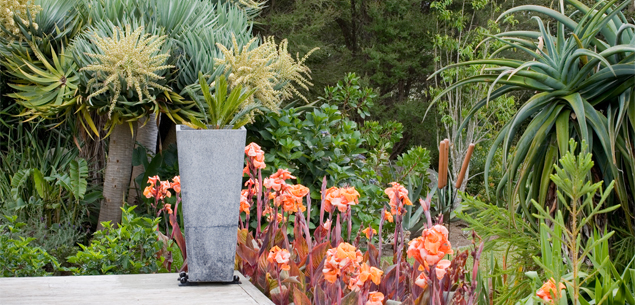We have the sexiest conversations in our bedroom in the mornings. After The Partner, a landscaper, has listened to three weather forecasts on the radio and worried about how he will arrange his working week around the rain, we talk about what we can see out of the window opposite our bed.
What we can see is a tall bank covered in tobacco weed. We have the same conversation about it three or four times a week, musing over what we can plant that will grow up in front of the tobacco weed so we can ultimately take it down.
After 18 months of this discussion, neither of us had found the perfect solution – cheap, well-shaped, bushy, fast growing, evergreen, with flowers, fragrance and fruit. But it came to me this morning, just after the answer to one of last night’s quiz questions fought its belated way to the top of my brain. Loquat.

The luscious loquat adds a subtropical look to any outdoor living area.
We already have two loquat trees and both are self-seeded. They’ve probably been here for 10 years and I’ve never taken the slightest bit of notice of them – apart from to grab and absent-mindedly eat the occasional fruit. But now that I think of it, they meet all the criteria of a species with which to replace the tobacco weed.
The loquat is indigenous to south-eastern China and is said to have been cultivated in Japan for more than 1000 years. It’s quite a good-looking evergreen with large, wellshaped leaves, white owers produced in stiff panicles, with a sweet, heady aroma that can be smelt from a distance.
The fruit are yellow or orange, and the taste is a mix of peach, citrus and mild mango. It has to be said that I have never done anything to enhance the growing conditions of our loquats. Now that I’ve decided to cultivate them, though, I’ve started swotting up on what they’ll need. I want very speedy growth, and I’m prepared to toil.

The fruit is good to eat fresh from the tree, and because of its high pectin levels, makes excellent jam.
Being a subtropical, they like to be warm, but not scorched, and they’re fairly wind and salt tolerant. They tolerate a bit of cold, although it does affect fruit production, and they appreciate frost protection in their youth. They are not particular about soil, but they do like drainage – although they’ll handle semi-wet soils or drought.
Loquats are only moderately nutrient hungry and once they’re established just one feed a year in late summer will do. Loquat has few natural pests. You sometimes get tip burn of the leaves in a dry summer, but it’s not damaging to the tree.
You can prune loquats either to maintain a nice shape or to open the internal growth to allow light in. After fruiting and before summer growth is the time to do it. If you get a good fruiter, take advantage. Loquats are high in vitamin A (but poor in vitamin C) and potassium. Eat them fresh off the tree, in fruit salad, or stone them and cook them for pies or as stewed fruit.

The well-shaped tree is evergreen, easy care, fast growing, and has flowers, fruit and fragrance.
If you want to make jam (they have good pectin levels for jam setting) leave in one or two of the stones to give a bit of bite. I’m planning on planting about a dozen of these little charmers on our bank, and I’ll let them grow to their full height, which is about four or five metres.
If you have room only for one, you’ll find it an excellent small tree for an urban garden, or an inner-city courtyard. It’ll behave beautifully in a container and will allow itself to be espaliered. How co-operative is that?




